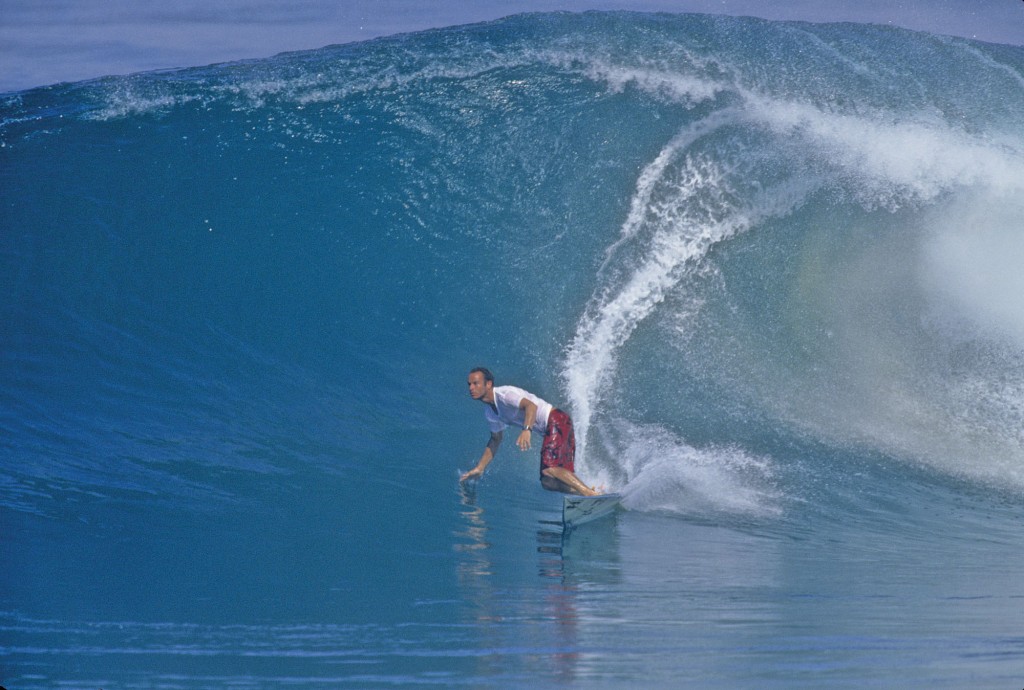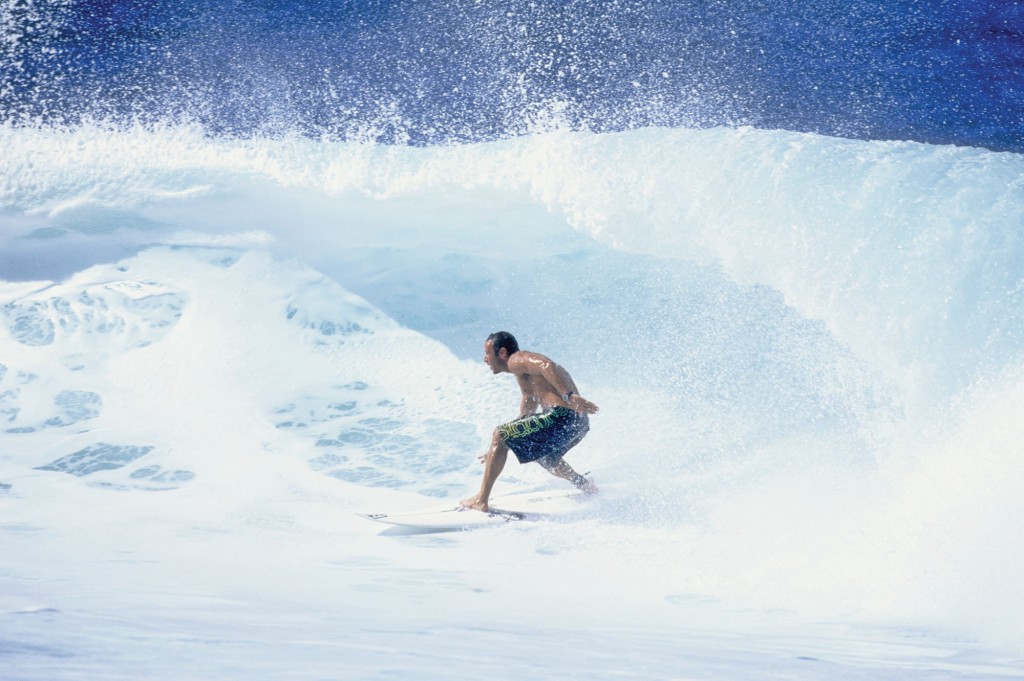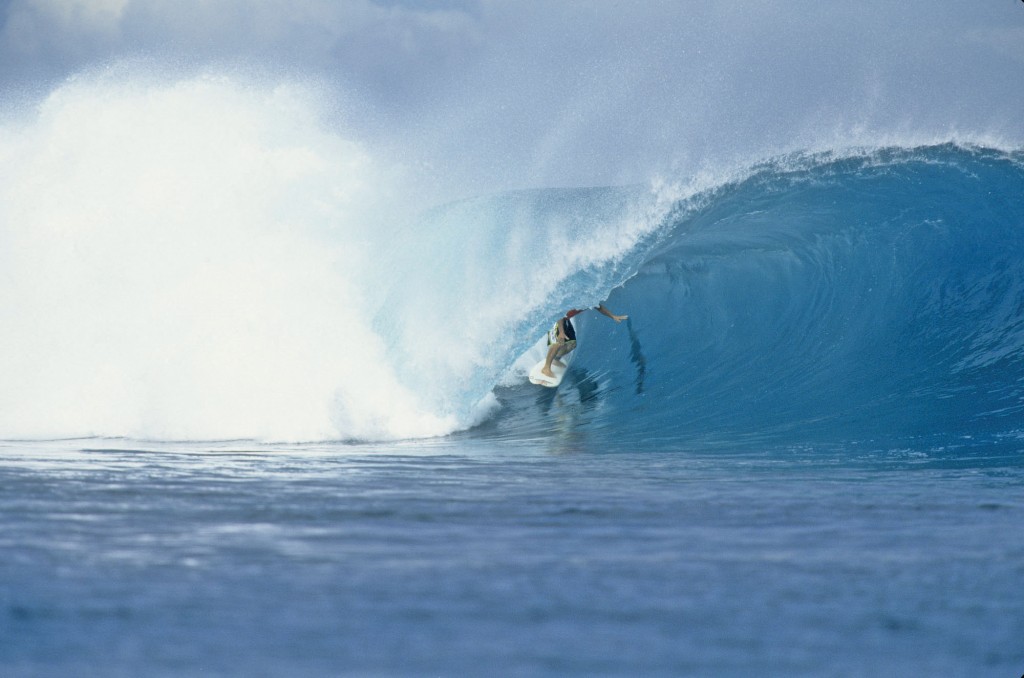A barrel of fun – frontside tube riding distilled
December 9th, 2011
Peter Townend, the 1976 World Champ, likes to tell the story of Gerry Lopez giving him the secret of riding the tube: “I was a grommet at Coolangatta, surfing Kirra, and I could get into the barrel, but I couldn’t get out,” relates PT. “So Lopez showed up on the Gold Coast with Jeff Hakman and Jack McCoy.
Being the brazen little grom that I was, I walked straight up to him and introduced myself. I told him I’d been surfing Kirra and he was interested in going to try the tubes there. So I straight-up told him that I was having trouble getting out of the tube. ‘Let me tell you a little secret’, Lopez confided. ‘You see that big water pipe over there? The next time you’re in the tube and you are having trouble, take your front hand and point it directly in the center of the cylinder.’ I went back to Kirra that very next day, and every time I put my hand in the eye of the cylinder I started making it out of the tube!
It’ a simple tip, but I never forgot it.” The history of tube riding is a storied affair primarily built around the training ground of Banzai Pipeline, where nearly all surfing’s early barrel techniques were developed beginning with Butch Van Artdalen’s initial encounters in 1962, earning him the first title of Mr. Pipeline.
Jock Sutherland was next in a succession of regal pipe masters that was most epitomized in the early 70s by the zen-like grace of stylist Gerry Lopez. The torch was passed to Shaun Tomson in the winter of 1976, when new equipment and new vision allowed Tomson to actually begin maneuvering inside the tube at Backdoor.
The Pipeline Masters contest created a forum for performance that has crowned a number of heirs to the throne, including multi-time winners, Rory Russell, Larry Blair, Derek Ho, Tom Carroll, Kelly Slater and Andy Irons. For aspiring experts there’s no other place so sought after, and dreamed about than the tube. To ride in the barrel requires commitment, skill, and the ability to read the waves in instant detail. The punishment for errors is severe; the prize is communion with the very essence of the sport of surfing. It is estimated that only one in twenty surfers can confidently negotiate the tube. Here are some takes by the world’s best, to give an edge to the upcoming 5%.
1. SPEED
Surviving the barrel is all about speed; how to get it, and how to control it. To get deep in a barrel, you need to decelerate, but to get out, you need as much speed as you can get. Learning how to decelerate and accelerate will give you control of your tube ride and therefore allow you to get as deep as you can, and still get out.
2. SHOULDER IN
“The best trick I can remind tube riders to remember is to keep your lead shoulder in. It completely changes the body positioning. At this point you can make adjustments in the tube. The key is to make the negotiation between not getting too high (so that you get sucked up the face and over) and not getting too low (so that you lose your speed or get caught by the falling lip.) Both Mick Fanning and Joel Parkinson have developed a new approach which puts their weight on the front foot almost exclusively. Their back foot is turned over – the heel is rarely touching the deck. They put all their weight on the front foot and with today’s boards, the speed is built around weighting and unweighting.” Shaun Tomson, World Champion.
3. SETTING UP
Another important aspect is setting up the turn to position for the tube: Sometimes a hollow section will be coming a ways down the line and you will want to make a couple of quick pumps to position yourself right where you want to be as the lip pitches. If the tube comes up quickly, sometimes it is necessary to make a quick hook turn on the face, get your rail in, and duck quickly under the lip.
STEP BY STEP
1. TAKE-OFF
Barreling waves are steep waves. Barreling waves are fast waves. Therefore, paddle fast, and at an angle. You must take off right on the peak, dropping down the face. Depending on how fast the wave is, you need to decide where to bottom turn. On fast waves like Pipe, you’ll drop to the bottom with no chance of engaging a fin. You must get the fin in as soon as possible.
2. BOTTOM TURN
This step is crucial. Too late and you’ll lose speed or find yourself outside the curtain. Too soon and you out-run the lip and have to stall to get back in. When you start your bottom turn, keep the knees bent like a coiled spring, and point your head in the direction you want to go next (back up the face). In small waves, now is the moment to make yourself small, to avoid decapitation.
3. PULLING IN
This is the moment of truth, when you must get yourself into the right part of the wave. You need to be half way between the top and the bottom of the wave. Too high and you get your neck chopped by the lip. Too low and you will be drilled. Use your back foot toes to engage the fin for more height. Release the toes and weight the front foot to drop back down the face. The key success factor for this: keep the high line as long as possible; height = speed, and speed = a safe exit.
4. SPEED
Surviving the barrel is all about speed; how to get it, and how to control it. To get deep in a barrel, you need to decelerate, but to get out, you need as much speed as you can get! Learning how to decelerate and accelerate will give you control of your tube ride and therefore allow you to get as deep as you can, and still get out the end.
5. DECELERATION
To get deeper, decelerate. Hand-dragging is the most effective way to lose speed when there is little room for maneuver. Stick your back hand into the wave… Not too sharply or you are gone! Weight shifting is the cleanest but slowest way to lose speed. Rock back onto your back foot. This brings the nose up and de planes the board, creating drag. Some small s-turns or wiggling; will slow your progress and allow the lip to catch up. This is hard to do in small tubes where you are crouched over the board.
6.THE RIDE
Staying with the lip is all about control. Accelerate and decelerate to keep you in the slot, using the techniques in step 5. Hold your line no matter what.
7. EXIT STRATEGY
You need to use all that speed you banked earlier and enough height to allow a sharp acceleration. Here are some tips on how to get the speed you need to exit:
Put weight on the front foot to reduce drag.
Rock back and forth while applying, and releasing, back-toe pressure. This engages then releases the fins and literally “squeezes” speed out of the board.
Keep low and tight; loose arms and heads create drag, and add to the risk of lip chop.
If you look at the exit, you will go through the exit! If you look at the roof, you will go through the roof. If you look at the board, you will drop too low.
This post was taken from Surfing The Manual: Advanced by Jim Kempton.

Tags: Peter Towend, surfing, surfing skills, Tube riding




